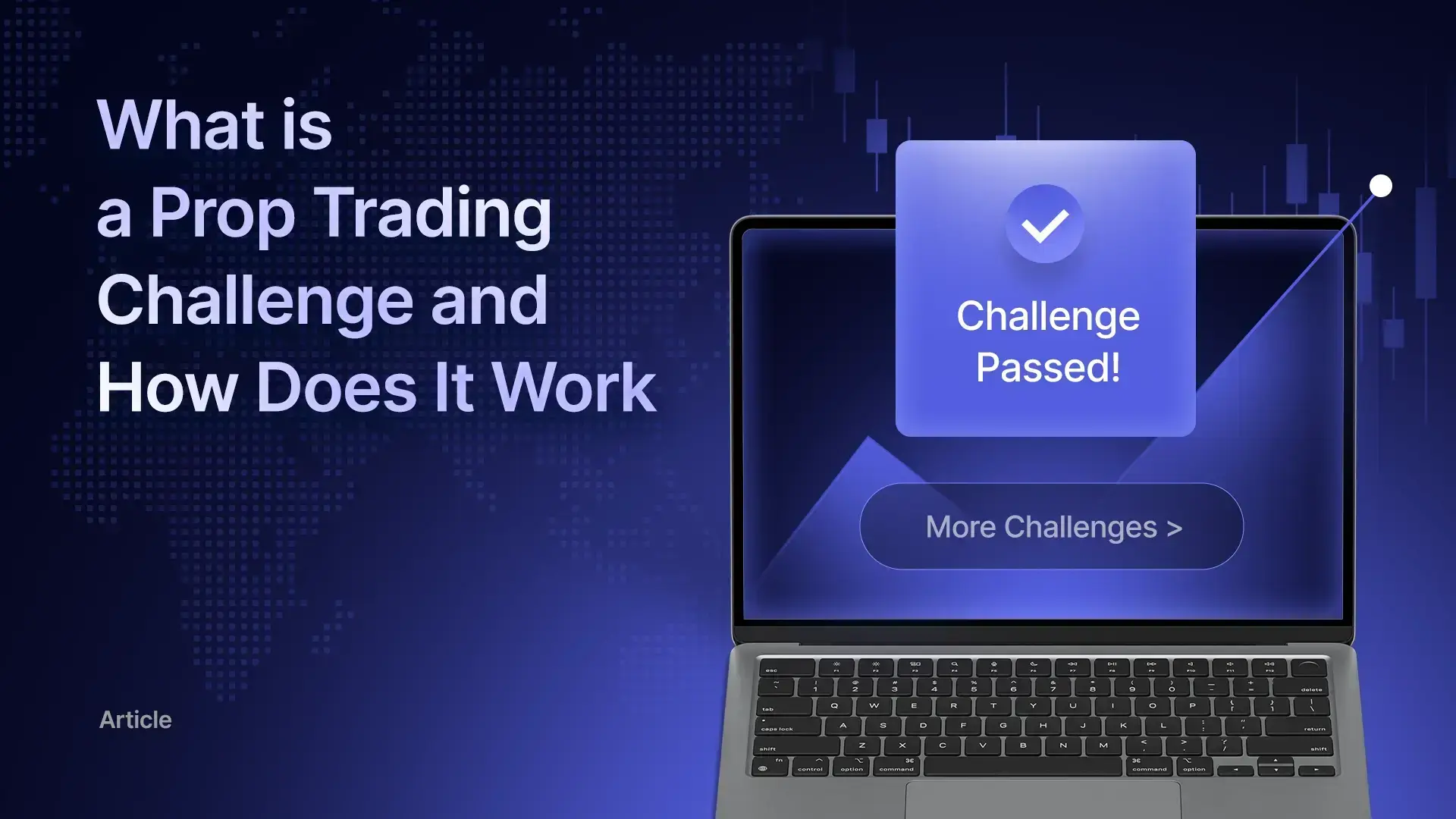Prop trading challenges have become the core evaluation system behind modern prop firms. As demand for funded accounts grows, prop firms rely on structured challenges to assess trader discipline, control risk, and scale operations efficiently. Search trends for terms like “prop trading challenge” and “funded account” continue to increase, which shows how quickly the model is expanding worldwide.
For a prop firm, a challenge does more than filter applicants. It creates a predictable evaluation flow, produces measurable performance data, and protects your capital by ensuring traders meet your criteria before accessing real funds. With thousands of traders entering the market every month, prop firms that build strong challenge structures are in the best position to grow and compete.
This guide breaks down how a prop trading challenge works from the perspective of prop firm owners and future founders. You will see why the evaluation model has become the backbone of prop firm operations and how the right technology helps you manage it all smoothly.
What Is a Prop Trading Challenge
A prop trading challenge is the evaluation system a prop firm uses to measure a trader’s consistency, discipline, and risk management before allocating capital. Instead of placing real funds at risk, your firm observes trader performance inside a simulated account. Traders must reach a profit target while following your risk rules, which gives you a reliable way to identify those who fit your business model.
From an operational standpoint, the challenge forms the foundation of your prop firm. It gives you structured data on trader behavior, reduces unnecessary exposure, and allows your firm to scale without raising capital requirements. Once a trader passes, they move into a funded stage where profit sharing begins. Most prop firms use splits between 70 to 90%, which helps attract quality traders without compromising sustainability.
With a challenge in place, you can maintain consistency across thousands of evaluations, filter out high-risk traders, and ensure that only those with stable performance advance into your funded accounts.
Why Prop Firms Use Evaluation Challenges
Prop trading challenges play a central role in how a prop firm operates. They are designed to support scalability, manage risk, and maintain a healthy trader portfolio.
Risk Protection
When large numbers of traders join your prop firm, not all of them have stable risk habits. A challenge allows you to observe how each trader handles drawdowns, manages losing streaks, and responds to volatile markets. Daily loss limits and overall drawdown limits help you identify traders who respect risk boundaries.
Evaluation at Scale
Prop firms grow quickly, and manual evaluation becomes impossible once hundreds or thousands of traders are active. A standardized challenge structure allows your firm to process traders consistently and gather performance insights automatically. This creates a scalable business model where growth does not overwhelm your internal resources.
Long-Term Sustainability
A trader who passes a well-designed challenge has already shown discipline, consistency, and rule adherence. These behaviors reduce your firm’s exposure when traders reach funded stages. The result is a more reliable pool of funded traders and a healthier payout system for your prop firm.
Key Components of a Typical Prop Trading Challenge
A successful challenge is built on several core components that shape your evaluation system. Understanding these elements helps you design rules that fit your firm’s goals.
Profit Targets
Most prop firms use profit targets between 8 to 10% for phase one. This gives you enough data to evaluate a trader’s ability to generate returns without promoting overly aggressive behavior.
Drawdown and Risk Limits
Your risk rules are the backbone of the evaluation. Key limits include:
- Maximum daily loss
- Maximum overall drawdown
Some prop firms use static drawdowns, while others use trailing versions. These limits allow you to track how traders manage losses and react under pressure.
Time Limits and Minimum Trading Days
Time windows help structure the challenge and prevent traders from relying on one or two lucky trades. Minimum trading days also ensure that you receive a meaningful sample of performance data.
Trading Rules and Restrictions
Rules related to news events, position holding, lot sizes, or specific strategies help keep the evaluation fair and controlled. These guidelines also provide consistency across different types of traders.
How a Prop Trading Challenge Works
A structured challenge follows a predictable sequence from purchase to funding. This makes it easier for your prop firm to manage large numbers of traders efficiently.
Step 1: Trader Selects Account Size
A trader chooses a challenge tier that matches their preferred capital size. This creates predictable pricing and helps your firm categorize traders by skill and risk appetite.
Step 2: Phase One
The trader works toward the initial profit target while following your drawdown and risk rules. This phase gives your firm high-value data about how the trader behaves under common market conditions.
Step 3: Phase Two or Verification
Phase two usually has a lower target and confirms consistency. It adds an extra layer of validation to ensure the trader’s phase one performance was genuine and repeatable.
Step 4: Funded Account
Once a trader passes all phases, they receive access to your prop firm’s capital. At this stage, the evaluation system transitions into your revenue-generating funded program.
Different Types of Prop Trading Challenges
Prop firms use different challenge structures depending on their business goals and target trader profiles.
Two-Step Evaluation
A two-phase structure offers balanced evaluation and reduces risk exposure. It remains the most common model among established prop firms.
One-Step Evaluation
This model shortens the evaluation timeline. It appeals to traders seeking faster access but may require stronger risk controls to maintain sustainability.
Instant Funding Models
Some prop firms provide immediate access to funded accounts with preset limitations. This requires well-designed risk systems to protect your capital from inexperienced traders.
Market-Specific Challenges
Forex, futures, and multi-asset challenges each have unique rule sets due to margin requirements and volatility characteristics. Customizing your evaluation helps match trader behavior with your firm’s operational strategy.
How Big the Prop Trading Challenge Space Is Today
Industry data shows that the prop trading sector is expanding rapidly, creating strong opportunities for prop firm owners.
According to WorldMetrics, the global prop trading industry is now valued at more than 20 billion USD, with annual growth projected around 7%. More than two thousand prop firms operate worldwide, with the United States leading in total count.
Data from BestPropFirms shows global search interest for funded account programs rising by more than 500% between 2020 and 2024. This surge demonstrates strong trader demand and increasing awareness of the evaluation model.
Research from QuantVPS and WorldMetrics also shows that:
- Challenge fees range from 100 to 600 USD
- Profit splits typically range from 70 to 90%
- Payouts from leading prop firms often reach millions per month
These numbers confirm that prop trading challenges are a scalable and sustainable business model when supported by proper systems and technology.
How to Evaluate a Prop Trading Challenge Before You Offer It
If you plan to launch or improve a prop firm, it is important to review your challenge model carefully.
Reputation and Transparency
Clear communication, stable rules, and consistent payout history create trust among traders and help your prop firm attract higher-quality applicants.
Balanced Rules
Profit targets, drawdown limits, and evaluation timelines should support your firm’s sustainability while giving disciplined traders a realistic path to funding.
Reliable Technology
A smooth challenge experience requires dependable platforms, accurate risk tracking, and real-time monitoring tools. Strong infrastructure prevents technical disputes and protects your firm’s reputation.
How YourPropFirm Helps You Design and Run Prop Trading Challenges
Everything discussed in this guide becomes far easier to execute with the right technology behind your prop firm. YourPropFirm provides a complete platform that supports the full challenge lifecycle, from trader onboarding to risk management and scaling.
You have full control over your challenge rules, account types, drawdown logic, payout terms, and progression flow. The platform handles automation, data tracking, account transitions, and trader activity monitoring, giving you a clear overview of your entire operation.
With these systems in place, you can focus on growing your prop firm, improving your challenge structure, and delivering a better experience for your traders. YourPropFirm equips you with the tools needed to create a professional, reliable, and scalable prop trading business that aligns with the standards outlined in this guide.




